Isodrones - the mystery of deep roots (2018-2023)

Table of Contents
Introduction
A fundamental question for hydrologists and ecologists is how water moves through ecosystems and how and in which quantities water entering the system as precipitation becomes available for plants, replenishes soil and groundwater reservoirs or transforms into runoff. Only recently, the biophysical process of plant transpiration received increased attention by the scientific community as it has been proven to be by far the largest flux of the global water balance (Barbeta & Peñuelas, 2017; Evaristo et al., 2015; Jasechko et al., 2013; McDonnell, 2014; Schlaepfer et al., 2014).
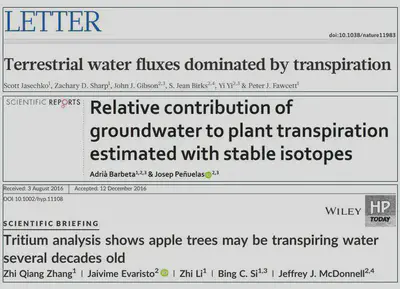
However, fundamental aspects are currently neither completely understood nor quantifiable related to the question how and from which reservoirs plants receive their water from (McDonnell, 2014). One of those is the functioning of deep, potentially groundwater tapping roots (the definition we use here is based on separating a plants’ root zone into a ‘lateral’ and ‘deep’ component). It is widely accepted that such roots are highly efficient in the acquisition of water once tapping the groundwater; however, they are rarely considered in the management of water resources, mainly because of the lack of quantitative methods (Maeght et al., 2013; Pierret et al., 2016).
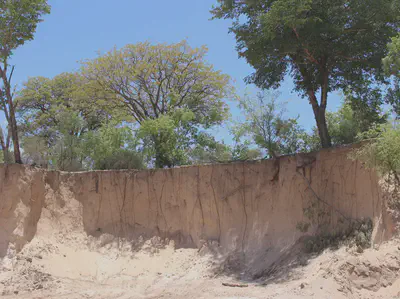
Functions of deep roots
Deep roots exist in different forms, of which tap, sinker and descending lateral roots are the most common (Canadell et al., 1996). Their main ecological functions are to provide stability for the plant and supply the it with water and nutrients. For some species (e.g. phreatophytes), survival can completely depend on the capability of roots to access the water table (Canadell et al., 1996; Kalisz & Stone, 1991) Especially when the supply from shallow soil water and precipitation are insufficient, the water uptake function of deep roots is crucial (e.g. in dry and rocky environments). In such cases - even if the fraction of roots reaching the water table is small - the efficiency of tap roots can be hundreds of times larger than roots in drier soil and large amounts of water can be transported (Canadell et al., 1996; Reicosky et al., 1964).
Deep roots are not only able to take up water but are also capable to redistribute water between different soil layers. Hydraulic lift (HL) or hydraulic redistribution (HR) is the nocturnal transport of water from moist to dry regions of the soil profile and is well studied since many decades (Burgess, 2011; Burgess et al., 2000; Burgess et al., 1998; Dawson, 1993; Ludwig et al., 2003; Richards & Caldwell, 1987). The morphology of root systems affects the plants ability to take up nutrients. If there is availability of essential nutrients at depth, but not at the surface (e.g. trace elements such as strontium, potassium or iodine) plants might prefer the deeper source even if water availability is less. This mechanism can also work the other way around. Similar to transporting of water, the before mentioned mechanism of hydraulic redistribution can also be used by the plant to redistribute nutrients (da Silva et al., 2011; Lambers et al., 2006) , but refer to (Maeght et al., 2013) for more examples). Finally, deep roots also play a role in physical and chemical weathering, can influence the biogeochemistry of carbon and have an impact on the soil fauna and microbial communities (Maeght et al., 2013).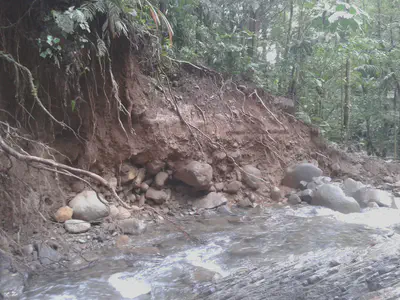
Why more research is needed
The habit of developing tap roots has been shown to be common across all climates; hence, they are of global significance (Lubczynski, 2011). The maximum depth of tap roots of an individual tree has been found to be 68 m (Canadell et al., 1996; Jennings, 1974). Nevertheless, scientific research deep roots is scattered and no significant methodological improvements have been achieved since the global analysis of deep roots by Canadell et al. in 1996 (Canadell et al., 1996; Maeght et al., 2013; Pierret et al., 2016). In fact, there is no generally applicable methodology available to quantify the contribution of deep rooting vegetation to overall transpiration and to evaluate their impact across different climatic and ecoregions. In a recent review on the current understanding of deep roots and their functions in ecosystems published by (Pierret et al., 2016), the authors state that “research on deep roots is hampered by the lack of appropriate methodology to study them accurately”. Further, the authors ask for “…unconventional investigations that involve a larger degree of risk…” (Pierret et al., 2016). This statement seems very conform to the ‘Freigeist’ program and constituted an excellent starting point for the ideas of this project.
“To a large extent, our knowledge of deep fine roots remains extremely limited due to the fact that research on deep roots is hampered by the lack of appropriate methodology to study them accurately. We need “more daring, unconventional investigations that involve a larger degree of risk…” (Pierret et al., 2016)
Project Goals
The overarching aim of this project is to develop a framework for quantifying the impact of deep roots on the water balance across different environments. We divided this main goal into three working packages with distinct goals (expressed as working packages - WP):
(WP1) Develop a methodology to identify groundwater-utilizing plants and quantification of water uptake through deep roots; separate evapotranspiration into transpiration through the lateral root zone, transpiration through tap roots and evaporation using novel stable isotope techniques (WP1). (WP2) Develop drone-based techniques for improving field-scale ecohydrological research (WP2). (WP3) Incorporate deep roots into (eco-) hydrological models and quantify the impact of deep roots on the regional water balance (WP3).
The figures down below depict the WP’s and how they are connected to each other and a conceptual illustration of the underlying ideas.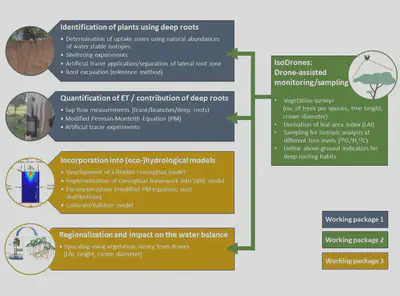
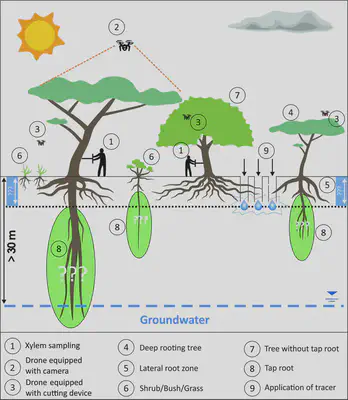
Hypothesis: “Deep water uptake (underneath the lateral root zone) is an important contributor to the overall transpirative flux of plants across all environments.” Ultimately, this project will provide a novel perspective on the water budget of the individual plant and for water management under climatic variability. In the context of recent scientific findings related to plant functioning, water acquisition zones and adaptability of the vegetation under various environmental conditions, a better understanding of the coupling between water input (precipitation, groundwater), soil water reservoirs, plants and the atmosphere as water output will be achieved.
Working Package I (WP I): Identification of deep roots and quantification deep root water uptake
The goal of WP I is to develop a methodology to identify groundwater-utilizing plants and to quantify water uptake through deep roots. Essential for this is to separate evapotranspiration ($ET$) into transpiration through the lateral root zone ($T_{lat}$); transpiration through deep roots ($T_{tap}$) and evaporation ($E$):
$$ ET = E + T_{lat} + T_{tap}$$
A major element to achieve this are techniques based on water stable isotopes, but also extensive plant physiological and soil hydraulic monitoring. Measurements of isoflux in trees and sap flow, for instance, will be conducted at several positions of the respective tree simultaneously, i.e. at the tap root directly, at the trunk, in branches. Recent advances in techniques utilizing water stable isotopes (Dubbert et al., 2014; Dubbert et al., 2013; Gaj et al., 2016; Oerter & Bowen, 2017; Werner & Dubbert, 2016; Volkmann et al., 2016; Volkmann et al., 2016) are applied and further developed. Whereas insitu methods for measuring soil water stable isotopes have become popular, no major achievements were reported in regard to measuring plant water isotopes directly (i.e. the isotopic composition of xylem). We utilize a novel ‘stem borehole’ technique to measure the isotopic composition of xylem water insitu.
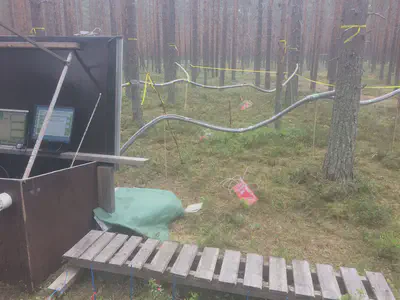
This will be accompanied by extensive plant physiological (sap flow, water potential, stomatal conductance, etc.) and soil monitoring (soil moisture, matric potential, temperature). In addition, tracer experiments (Beyer et al., 2016; Kulmatiski et al., 2010; Priyadarshini et al., 2016) for quantitative studies along the soil-vegetation atmosphere interface will be utilized. Finally, an important component of this working package is the investigation of the transport of trace elements (Lintern et al., 2013) through plants, which might yield an additional indicator and constraint for mixing models. The following questions will be addressed in WP I:
How can we improve the identification deep water uptake?
How can we quantify deep root water uptake?
How can we reduce the uncertainty of current techniques? (e.g. mixing models)
Working Package II (WP II): UAV (Drone-)-based methods in ecohydrologyPermalink
Research on deep roots has and continues to be struggle for simple reasons: It is extremely labour-intensive, methods are highly invasive and results are difficult to replicate. But maybe there exist above-ground indicators that can tell us if a particular plant has deep roots - or not? The center of WP II is to investigate, if such indicators exist.
Is it possible to identify above-ground indicators for deep rooting strategies of plants?
To provide a simple, comprehensive example, imagine a forest suffering water stress because of hydrological drought. Plants will close there stomata to avoid further water losses and hence, leaf temperatures will increase - unless a particular tree has access to water. This, on the other hand, would be reflected by (comparably) lower leaf temperatures. But not only temperature, also other indicators that can be derived from multi- or hyperspectral information, might be suitable as indicators for deep root water uptake - but which?

Second, sample collection from trees is often limited to the lower part of the tree which can lead to biased interpretations. It also hinders a holistic description of within-plant water transport processes. Therefore, another focal area of this working package is dedicated to the design and assembling of a remote-controlled drone that is capable of collecting samples from both leaves and branches at any desired position within the canopy.
Can drones be utilized for remote sample collection (leaves, branches) from trees? How can such sampling strategies improve the holistic description of within-plant water transport processes?
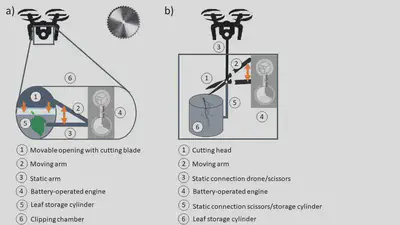
A third aspect that is addressed in WP II is the fact that for the estimation of ET and the application of ecohydrological models, a number of input parameters is required. Most field methods are highly work intensive and often provide data only on a point-scale (e.g. for a single tree). With the abovementioned approaches and a high-resolution camera, a number of parameters for ecohydrological modeling can be derived from systematic flight-overs of the study area.
How can drone-derived parameters assist the parameterization of (eco-)hydrological models?
How can water acquisition through deep roots be regionalized using drone-based measures?
Working Package III (WP III): Incorporating deep roots into (eco-)hydrological models
There is no generally applicable and easily transferable conceptual model accounting for water uptake through both shallow (i.e. the lateral root zone) and deep roots (i.e. through tap roots). Soil-vegetation-atmosphere transfer (SVAT) models commonly used for the simulation of the unsaturated zone (e.g. HYDRUS) often use a simplified representation of plants and the root zone is implemented using a root distribution for a single tree or a ‘mean’ rooting distribution. Consequently, the impact of deep root water uptake on the water balance is often neglected, difficult to represent spatially and error-prone. In WP III the information gathered in the other working packages will confluence and be used to develop a model which is capable of incorporating deep rooting in a spatially distinct manner. A key element will therefore be to account for water uptake through the lateral root zone ($T_{lat}$) and deep water uptake ($T_{tap}$), respectively.
Upscaling (Regionalization) will be achieved by developing and applying separate models accounting for different functional plant groups (i.e. deep-water-using and non-deep-water-using, respectively). Based on the vegetation surveys (WP II) and the identification and quantification of deep-water-using species (WP I), the number of individuals per functional group can be used to determine the impact of $T_{lat}$ and $T_{tap}$ on the catchment scale and, subsequently, on the regional water balance.
How can water uptake through deep roots conceptually be described in order to allow a flexible treatment in models?
How can deep roots and the co-existence of deep and shallow rooting plant species be incorporated into SVAT modelling?
How does this affect the water balance at a regional scale (upscaling)?
References
Allison, G. B. 1988. “A Review of Some of the Physical, Chemical and Isotopic Techniques Available for Estimating Groundwater Recharge.” In Estimation of Natural Groundwater Recharge, edited by Ian Simmers, 49–72. Springer Netherlands. http://dx.doi.org/10.1007/978-94-015-7780-9{\_}4.
Allison, G. B., C. J. Barnes, MW Hughes, and F. W. Leaney. 1984. “Effect of climate and vegetation on oxygen-18 and deuterium profiles in soils.” In International Symposium on Isotope Hydrology in Water Resources Development, 105–22. Vienna, Austria: International Atomic Energy Agency (IAEA). http://www.researchgate.net/publication/201995709{\_}Effect{\_}of{\_}climate{\_}and{\_}vegetation{\_}on{\_}oxygen-18{\_}and{\_}deuterium{\_}profiles{\_}in{\_}soils.
Barbeta, Adrià, and Josep Peñuelas. 2017. “Relative contribution of groundwater to plant transpiration estimated with stable isotopes.” Scientific Reports 7 (1): 10580. https://doi.org/10.1038/s41598-017-09643-x.
Beyer, M., P. Koeniger, M. Gaj, J. T. Hamutoko, H. Wanke, and T. Himmelsbach. 2016. “A Deuterium-based labeling technique for the investigation of rooting depths, water uptake dynamics and unsaturated zone water transport in semiarid environments.” Journal of Hydrology, December. https://doi.org/10.1016/j.jhydrol.2015.12.037.
Burgess, S, J. S. Pate, M. A. Adams, and T. E. Dawson. 2000. “Seasonal Water Acquisition and Redistribution in the Australian Woody Phreatophyte, Banksia prionotes.” Annals of Botany 85 (2): 215–24. https://doi.org/10.1006/anbo.1999.1019.
Burgess, Stephen S. O. 2011. “Can hydraulic redistribution put bread on our table?” Plant and Soil 341 (1-2): 25–29. https://doi.org/10.1007/s11104-010-0638-1.
Burgess, Stephen S. O., Mark A. Adams, Neil C. Turner, and Chin K. Ong. 1998. “The redistribution of soil water by tree root systems.” Oecologia 115 (3): 306–11. https://doi.org/10.1007/s004420050521.
Canadell, J., R. B. Jackson, J. B. Ehleringer, H. A. Mooney, O. E. Sala, and E.-D. Schulze. 1996. “Maximum rooting depth of vegetation types at the global scale.” Oecologia 108 (4): 583–95. https://doi.org/10.1007/BF00329030.
Chimner, Rodney A., and David J. Cooper. 2004. “Using stable oxygen isotopes to quantify the water source used for transpiration by native shrubs in the San Luis Valley, Colorado U.S.A.” Plant and Soil 260 (1/2): 225–36. https://doi.org/10.1023/B:PLSO.0000030190.70085.e9.
Clark, Ian D., and Peter Fritz. 1997. Environmental Isotopes in Hydrogeology. CRC Press. https://www.researchgate.net/publication/201169434{\_}Environmental{\_}Isotopes{\_}in{\_}Hydrogeology{\_}Lewis.
Cook, P. G., I. D. Jolly, F. W. Leaney, G. R. Walker, G. L. Allan, L. K. Fifield, and G. B. Allison. 1994. “Unsaturated zone tritium and chlorine 36 profiles from southern Australia: Their use as tracers of soil water movement.” Water Resources Research 30 (6): 1709–19. https://doi.org/10.1029/94WR00161.
Cook, P. G., and A. P. O’Grady. 2006. “Determining soil and ground water use of vegetation from heat pulse, water potential and stable isotope data.” Oecologia 148 (1): 97–107. https://doi.org/10.1007/s00442-005-0353-4.
Dawson, Todd E. 1993. “Hydraulic lift and water use by plants: implications for water balance, performance and plant-plant interactions.” Oecologia 95 (4): 565–74. https://doi.org/10.1007/BF00317442.
Dawson, Todd E., and James R. Ehleringer. 1991. “Streamside trees that do not use stream water.” Nature 350 (6316): 335–37. https://doi.org/10.1038/350335a0.
Dawson, Todd E., and John S Pate. 1996. “Seasonal water uptake and movement in root systems of Australian phraeatophytic plants of dimorphic root morphology: a stable isotope investigation.” Oecologia 107 (1): 13–20. https://doi.org/10.1007/BF00582230.
Dubbert, Maren, Matthias Cuntz, Arndt Piayda, Cristina Maguás, and Christiane Werner. 2013. “Partitioning evapotranspiration: Testing the Craig and Gordon model with field measurements of oxygen isotope ratios of evaporative fluxes.” Journal of Hydrology 496 (July): 142–53. https://doi.org/10.1016/j.jhydrol.2013.05.033.
Dubbert, Maren, Matthias Cuntz, Arndt Piayda, and Christiane Werner. 2014. “Oxygen isotope signatures of transpired water vapor: the role of isotopic non-steady-state transpiration under natural conditions.” The New Phytologist 203 (4): 1242–52. https://doi.org/10.1111/nph.12878.
Dubbert, Maren, Arndt Piayda, Matthias Cuntz, Alexandra C Correia, Filipe Costa E Silva, Joao S Pereira, and Christiane Werner. 2014. “Stable oxygen isotope and flux partitioning demonstrates understory of an oak savanna contributes up to half of ecosystem carbon and water exchange.” Frontiers in Plant Science 5 (January): 530. https://doi.org/10.3389/fpls.2014.00530.
Evaristo, Jaivime, Scott Jasechko, and Jeffrey J. McDonnell. 2015. “Global separation of plant transpiration from groundwater and streamflow.” Nature 525 (7567): 91–94. https://doi.org/10.1038/nature14983.
Gaj, M., M. Beyer, P. Koeniger, H. Wanke, J. Hamutoko, and T. Himmelsbach. 2016. “In situ unsaturated zone water stable isotope (2H and 18O) measurements in semi-arid environments: A soil water balance.” Hydrology and Earth System Sciences 20 (2). https://doi.org/10.5194/hess-20-715-2016.
Grossiord, Charlotte, Sanna Sevanto, Todd E. Dawson, Henry D. Adams, Adam D. Collins, Lee T. Dickman, Brent D. Newman, Elizabeth A. Stockton, and Nate G. McDowell. 2016. “Warming combined with more extreme precipitation regimes modifies the water sources used by trees.” New Phytologist, September. https://doi.org/10.1111/nph.14192.
Jasechko, Scott, Zachary D Sharp, John J Gibson, S Jean Birks, Yi Yi, and Peter J Fawcett. 2013. “Terrestrial water fluxes dominated by transpiration.” Nature 496 (7445): 347–50. https://doi.org/10.1038/nature11983.
Jennings, C. M. H. 1974. “The Hydrology of Botswana.” PhD thesis, University of Natal, South Africa.
Kalisz, P. J., and E. L. Stone. 1991. “On the maximum extent of tree roots.” Forest Ecology and Management 46 (1): 59–102. https://doi.org/DOI: 10.1016/0378-1127(91)90245-Q.
Kulmatiski, Andrew, Karen H Beard, Richard J T Verweij, and Edmund C February. 2010. “A depth-controlled tracer technique measures vertical, horizontal and temporal patterns of water use by trees and grasses in a subtropical savanna.” The New Phytologist 188 (1): 199–209. https://doi.org/10.1111/j.1469-8137.2010.03338.x.
Lambers, H., M. W. Shane, Cramer M. D., S. J. Pearse, and E. J. Veneklaas. 2006. “Root Structure and Functioning for Efficient Acquisition of Phosphorus: Matching Morphological and Physiological Traits.” Annals of Botany 98 (4): 693–713. https://doi.org/10.1093/aob/mcl114.
Lintern, Melvyn, Ravi Anand, Chris Ryan, and David Paterson. 2013. “Natural gold particles in Eucalyptus leaves and their relevance to exploration for buried gold deposits.” Nature Communications 4 (1): 2274. https://doi.org/10.1038/ncomms3614.
Lubczynski, M. W. 2011. “Groundwater Evapotranspiration: Underestimated Role of Tree Transpiration and Bare Soil Evaporation in Groundwater Balances of Dry Lands,” 183–90. https://doi.org/10.1007/978-94-007-1143-321.
Ludwig, F., T. E. Dawson, H. de Kroon, F. Berendse, and H. H. T. Prins. 2003. “Hydraulic lift in Acacia tortilis trees on an East African savanna.” Oecologia 134 (3): 293–300. https://doi.org/10.1007/s00442-002-1119-x.
Maeght, Jean-Luc, Boris Rewald, and Alain Pierret. 2013. “How to study deep roots-and why it matters.” Frontiers in Plant Science 4: 299. https://doi.org/10.3389/fpls.2013.00299.
McDonnell, Jeffrey J. 2014. “The two water worlds hypothesis: ecohydrological separation of water between streams and trees?” Wiley Interdisciplinary Reviews: Water, April, n/a–n/a. https://doi.org/10.1002/wat2.1027.
Oerter, Erik J., and Gabriel Bowen. 2017. “In situ monitoring of H and O stable isotopes in soil water reveals ecohydrologic dynamics in managed soil systems.” Ecohydrology 10 (4): e1841. https://doi.org/10.1002/eco.1841.
Pierret, Alain, Jean-Luc Maeght, C. Clement, J.-P. Montoroi, C. Hartmann, and S. Gonkhamdee. 2016. “Understanding deep roots and their functions in ecosystems: an advocacy for more unconventional research.” Annals of Botany, July. https://doi.org/10.1093/aob/mcw130.
Priyadarshini, K. V. R., Herbert H. T. Prins, Steven de Bie, Ignas M. A. Heitkönig, Stephan Woodborne, Gerrit Gort, Kevin Kirkman, Fulco Ludwig, Todd E. Dawson, and Hans de Kroon. 2016. “Seasonality of hydraulic redistribution by trees to grasses and changes in their water source use that change tree-grass interactions.” Ecohydrology 9 (2): 218–28. https://doi.org/10.1002/eco.1624.
Reicosky, D. C., R. J. Millington, A. Kute, and D. B. Peters. 1964. “Patterns of water uptake and root distribution of soybeans (Glycine max) in the presence of a water table.” Agronomy Journal 64: 292–97.
Richards, J. H., and M. M. Caldwell. 1987. “Hydraulic lift: Substantial nocturnal water transport between soil layers by Artemisia tridentata roots.” Oecologia 73 (4): 486–89. https://doi.org/10.1007/BF00379405.
Rings, J., T. Kamai, M. Kandelous, P. Hartsough, J. Simunek, J. A. Vrugt, and J. W. Hopmans. 2013. “Bayesian Inference of Tree Water Relations Using a Soil-Tree-Atmosphere Continuum Model.” Procedia Environmental Sciences 19 (January): 26–36. https://doi.org/10.1016/j.proenv.2013.06.004.
Rothfuss, Youri, and Mathieu Javaux. 2016. “Isotopic approaches to quantifying root water uptake and redistribution: a review and comparison of methods.” Biogeosciences Discussions, October, 1–47. https://doi.org/10.5194/bg-2016-410.
Schlaepfer, Daniel R., Brent E. Ewers, Bryan N. Shuman, David G. Williams, John M. Frank, William J. Massman, and William K. Lauenroth. 2014. “Terrestrial water fluxes dominated by transpiration: Comment.” Ecosphere 5 (5): 61. http://dx.doi.org/10.1038/nature12925.
Silva, Eduardo Vinícius da, Jean-Pierre Bouillet, José Leonardo de Moraes Gonçalves, Cassio Hamilton Abreu Junior, Paulo Cesar Ocheuze Trivelin, Philippe Hinsinger, Christophe Jourdan, Yann Nouvellon, José Luiz Stape, and Jean-Paul Laclau. 2011. “Functional specialization of Eucalyptus fine roots: contrasting potential uptake rates for nitrogen, potassium and calcium tracers at varying soil depths.” Functional Ecology 25 (5): 996–1006. https://doi.org/10.1111/j.1365-2435.2011.01867.x.
Volkmann, Till H. M., Kristine Haberer, Arthur Gessler, and Markus Weiler. 2016. “High-resolution isotope measurements resolve rapid ecohydrological dynamics at the soil-plant interface.” New Phytologist 210 (3): 839–49. https://doi.org/10.1111/nph.13868.
Volkmann, Till H. M., Kathrin Kühnhammer, Barbara Herbstritt, Arthur Gessler, and Markus Weiler. 2016. “A method for in situ monitoring of the isotope composition of tree xylem water using laser spectroscopy.” Plant, Cell & Environment 39 (9): 2055–63. https://doi.org/10.1111/pce.12725.
Werner, Christiane, and Maren Dubbert. 2016. “Resolving rapid dynamics of soil-plant-atmosphere interactions.” New Phytologist 210 (3): 767–69. https://doi.org/10.1111/nph.13936.
Zhao, Liangju, Lixin Wang, Lucas A. Cernusak, Xiaohong Liu, Honglang Xiao, Maoxian Zhou, and Shiqiang Zhang. 2016. “Significant Difference in Hydrogen Isotope Composition Between Xylem and Tissue Water in Populus Euphratica.” Plant, Cell & Environment 39 (8): 1848–57. https://doi.org/10.1111/pce.12753.